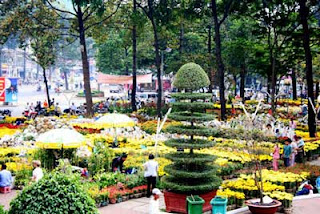This beautiful, delectable, low key sweet treat is very common in Viet Nam. It's made of mainly sweet rice gluten wrapped around a ball of mung bean paste and coated in sesame seeds. After the deep fry, its gorgeous orange color makes you want to sink your teeth into its crunchy nutty shell.
My husband is very picky on banh cam. It has to be crunchy, but not too chewy; the dough has to be tasty. The filling has to have the right amount of sweetness, aroma and softness. He prefers it in a smaller size so each bite contains both dough and filling.
Last weekend, we spent the Vietnamese New Year with my parents in So Cal. We had banh cam from a couple of diffrent places. My husband really likes banh cam from a lady who sold it on the street at the New Year parade. Her banh cam are about walnut size, but packed with flavor and a hearty crunch; they were quite delicious. My husband kept some for the next day just to see if the crispiness of the shell would last; turns out it lasts for 2 days. We never had banh cam like these before. Unfortunately, we were not able to find these at any of the markets nor did we find the lady. With banh cam, it's all about the crunch and the flavor of the filling.
Just to sastify my husband's craving, I decided to do some research on banh cam. Last night, I finally got my recipe down and started to experiment with the help of my oldest daughter.
We made 90 golf-ball size banh cam. The filling is mung bean paste and shredded coconut. The result was better than we had anticipated; they were crunchy, soft, flavorful, but not oily at all. My banh cam is still so crispy after I leave it out for a day. In the middle of the night, my daughter woke up from her sleep to ask for them only to fall back to sleep seconds later; it was hilarious. She ate at least 6 of them for breakfast the following day.
This time I record a part of the process. Thanks to my dear husband who surprised me with a brand new 12 megapixel camera which has the ability to record HD video to replace the antique 4.0 megapixel point and shoot Minolta.
Play this video clip on How to make Banh Cam Balls. There's a part in this video that is a bit shaky. Sorry guys, I had to make the pastries and recorded it myself, so the quality control isn't perfect.
* * *
*
RECIPE: Bánh Cam
*
Dough
1 bag Glutinous Rice Flour, 16 oz or about 4 1/2 cups (bột nếp)
3 tablespoons of Rice Flour (bột gạo)
2 teaspoons of Baking Powder
1 3/4 cups of Water.
1 1/4 cup of Sugar
2 tablespoon of Oil
3/4 cup of Mashed Potato, boiled a fresh potato, removed skin and mashed it
or 1/2 cup of potatoes flake
2 teaspoons of pure Vanilla Extract
1 bag of White Sesame Seeds
1 bag Glutinous Rice Flour, 16 oz or about 4 1/2 cups (bột nếp)
3 tablespoons of Rice Flour (bột gạo)
2 teaspoons of Baking Powder
1 3/4 cups of Water.
1 1/4 cup of Sugar
2 tablespoon of Oil
3/4 cup of Mashed Potato, boiled a fresh potato, removed skin and mashed it
or 1/2 cup of potatoes flake
2 teaspoons of pure Vanilla Extract
1 bag of White Sesame Seeds
Bring water, sugar and oil to boil. Add mashed potato or potatoes flake and stir it. Remove from heat. Add vanilla extract and let it cool down for about 5 minutes. Pour the mixture through the strainer, smash the mashed potatoe in the strainer. Scrape mashed potato off the outside of the strainer. If you use potatoes flake, you don't need to use the strainer.
*
Filling
1/2 teaspoon Salt
1 bag of Peeled and Split Mung Beans (about 1 1/2 cups)
1 1/4 cup of Sugar
2 cups of Grated Coconut, optional
2 tablespoons of oil
2 teaspoon of Pure Vanilla Extract
1/2 teaspoon of Salt
Add the remaining ingredients to the mung beans pot. The mung beans now are mushy because of the sugar we just added in. Bring it back to the stove and simmer it until it's thick. Make sure to stir it constantly so the mung beans won't stick to the pot. Cool off the mixture in room temperature. Divide beans paste into balls equally to the dough balls.
*
Prepare Pastry Balls
Take a ball of dough, and roll it with your palms to make ball, then flatten it.
Take a bean paste ball, put in the middle of the round flat dough.
Close the dough to make a ball.
Roll the ball in sesame seeds.
Heat a pot of oil at high. To test the heat of the oil, dip a chopstick into the oil. If you see bubbles rise around the chopstick, your frying oil is hot enough.
Reduce heat to medium. Deep fry the pastry until it's golden and puffy. It takes about 15 minutes.
Remove it and set it on a few paper towels to dry off the oil.


















































